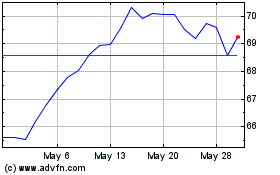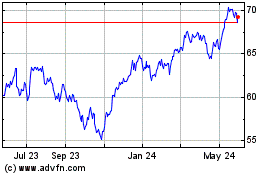The European economy has finally turned around with reduced debt
concerns, considerable growth in some key nations like the U.K.,
Germany and France, a stronger currency and respectable economic
data at regular intervals.
All major nations in the Eurozone – France, Germany, the
Netherlands, Italy and Denmark-- emerged out of recession last
year. Markit’s Flash Eurozone Composite Purchasing Managers Index
(PMI), which measures overall business activity, grew to 53.2
in January, the fastest clip in two and a half years, suggesting
that the region is well on track to recovery.
Strength in the manufacturing sector exhibited the fastest
expansion since May 2011. The German PMI is hovering at a 32-month
high level while reduction in French PMI moderated. Struggling
regions like Greece and Spain are also recording steady growth in
manufacturing activity.
Investors should, however, note that recovery is still in its
nascent stage and things are not yet out of the woods as
deflationary risks loom large with credit growth data for December
recording a month-on-month shrinkage. The present inflation
level at 0.7% (at the end of January 2014) remains well behind the
ECB target of 2.0%.
However, as per ECB, the retrenchment in December credit growth
might be a seasonal phenomenon as banks intended to clean their
balance sheets prior to an ECB review and stress tests for 2013.
The ECB also anticipates a rise in demand across all loan
categories for the first quarter of 2014.
Thus, though the region is still to attain sustainable growth, just
the end of a long-run recession is in itself great news. Investors
are also turning more positive on the continent.
Thus, given the region’s slow-but-assuring fundamentals, a look at
the top ranked ETF in Europe, or even just some countries in the
Eurozone could be a good idea, especially based on our Zacks ETF
Ranking system (read: Play a Resurgent Europe with These ETFs).
About the Zacks ETF Rank
The Zacks ETF Rank provides a recommendation for the ETF in the
context of our outlook for the underlying industry, sector, style
box or asset class (Read: Zacks ETF Rank Guide). Our proprietary
methodology also takes into account the risk preferences of
investors. ETFs are ranked on a scale of 1 (Strong Buy) to 5
(Strong Sell) while they also receive one of three risk ratings,
namely Low, Medium or High.
The aim of our models is to select the best ETFs within each risk
category. We assign each ETF one of the five ranks within each risk
bucket. Thus, the Zacks ETF Rank reflects the expected return of an
ETF relative to other products with a similar level of risk.
For investors seeking to apply this methodology to their portfolio
in the European equities space, we have taken a closer look at the
top ranked FEP. This ETF has a Zacks ETF Rank of 1 or ‘Strong Buy’
(see the full list of top ranked ETFs) and is detailed below:
FEP in Focus
Launched in April 2011,
First Trust Europe
AlphaDEX Fund ETF (
FEP) looks to offer
enhanced exposure to the Defined Europe Index before fees and
expenses which is a modified equal-dollar weighted index (read: Top
Ranked Europe ETF in Focus: EZU).
The benchmark is designed by the S&P to objectively
identify and select stocks from the S&P Europe BMI Index that
may generate positive alpha relative to traditional passive-style
indices through the use of the AlphaDEX selection methodology.
All the component stocks in a benchmark are ranked separately on
both growth factors like price appreciation, sales to price and
one-year sales growth as well as value factors including book value
to price, cash flow to price and return on assets.
The top 200 ranked stocks in the benchmark are then divided into
quintiles and each stock is weighted and ranked equally within each
quintile with top rated stocks getting more assets.
The fund, though not among the most popular ones in the Europe
equities space, has decent assets of about $504.8 million. Its
trading volume of around 170,600 shares a day also suggests modest
liquidity.
The choice is a bit costly with 57 basis points in fees a year
which is slightly higher than the average expense ratio in the
Europe equities space. Its enhanced approach has helped to increase
the price, though it could be worth it for some investors.
FEP Portfolio
With 199 stocks in its basket, this fund from First Trust puts only
8.93% of its total assets in the top 10 holdings with no company
accounting for more than 1.04% of the total, suggesting very low
concentration risk. Top companies include Faurecia, Piraeus Bank
S.A. and Valeo S.A., three of which account for around 3.07% of the
assets.
In terms of sector exposure, the top allocation, financials,
comprise a little greater than one-fifth of the total assets
followed by consumer discretionary companies making up around
17.78%. Beyond this, industrials (17.54%) and utilities (10.8%)
round out the top four, while Healthcare (1.34%) gets the least
weight.
As far as country allocations go, France takes up the top spot with
18.65% of the total closely followed by the U.K. at 17.55%. Germany
with about 11.28% of the assets fills up the third place.
Style-wise, the fund has a nice mix of value and growth stocks. The
fund is well-diversified capitalization wise as well, with mid caps
grabbing 45% share of assets followed by large caps (39%). FEP is
also a good tool for international diversification as it has a low
correlation with the S&P 500 Index as indicated by an R-squared
of 25.1% against the S&P 500.
The fund has returned around 22.54% over the last one year (as of
January 30) surpassing the biggest European fund by assets
Vanguard FTSE Europe ETF’s (
VGK)
14.5% return. The fund is currently hovering a little lower than
the 52-week high. FEP pays out a yield of 1.56% per annum.
Bottom Line
This ETF is appropriate for investors looking for a targeted bet on
European stocks but with a cautious stance. Given the AlphaDEX
methodology, equal-weighted approach, tilt toward stronger nation –
all indicate that FEP has a relatively low risk outlook. Notably
the U.K. economy – FEP’s second largest allocation – is now
expanding at the fastest pace since 2007.
Just one word of caution, the fund is unhedged, making it
vulnerable to any weakness in the Euro which has more than 60%
exposure, though recent trends suggest that this doesn’t look to be
too much of an issue in 2014 (read: Forget Europe's Currency Risks
with These Hedged ETFs).
Want the latest recommendations from Zacks Investment Research?
Today, you can download
7 Best Stocks for the Next 30
Days. Click to get this free report >>
To read this article on Zacks.com click here.
Zacks Investment Research
Want the latest recommendations from Zacks Investment Research?
Today, you can download 7 Best Stocks for the Next 30 Days. Click
to get this free report
Vanguard FTSE Europe (AMEX:VGK)
Historical Stock Chart
From Jan 2025 to Feb 2025

Vanguard FTSE Europe (AMEX:VGK)
Historical Stock Chart
From Feb 2024 to Feb 2025
